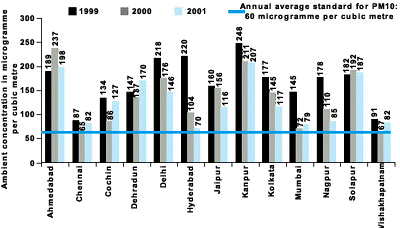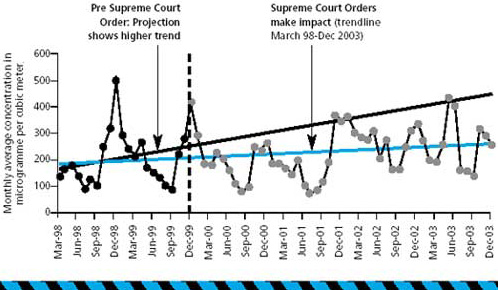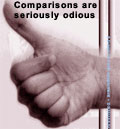 |
|
Car companies are aggressive about diesel cars. Consider a recent advertisement. It says: "You start saving even before you start driving". That’s not true (see: p 78). What’s true is that all carmakers take drastic advantage of government’s policy to keep diesel prices low. Worse, companies can get away with the white lies they put out in their ads: Government is least concerned. It plays along, allowing auto companies to dangle the bait of petty savings, at an enormous cost to public health.
Foreseeing future trouble, the Centre for Science and Environment (CSE) had campaigned to have private diesel cars banned in Delhi, way back in 1999. Deadly facts about diesel toxicity and health effects were beginning to pour in from other parts of the world. A big finding: diesel fumes consisted of 10-100 times more particles than petrol exhaust, and were several times more toxic. At the same time, car fleets in Indian cities were beginning to dieselise at breakneck speed; the direct subsidy on diesel had been dismantled, and petrol attracted higher taxes. Public health, impacted by diesel quality standards languishing at Euro 0 level, didn’t matter; a cheap run for profit did. Subsequently, public transport has moved to CNG under Supreme Court direction, to cut down on toxic particulate emissions. But private luxury cars are swelling. Even now, the country has no roadmap for clean diesel technology (see: p70-71).
IT'S STILL HIGH: Levels of deadly particles in Indian cities |
 |
| Source:
Computed on the basis of following reports: 1. Anon 2003, National Ambient Air Quality Status – 2001, Central Pollution Control Board, Ministry of Environment and Forests, Government of India, New Delhi 2. Anon 2002, National Ambient Air Quality Status – 2000, Central Pollution Control Board, Ministry of Environment and Forests, Government of India, New Delhi 3. Anon 2002, National Ambient Air Quality Status – 1999, Central Pollution Control Board, Ministry of Environment and Forests, Government of India, New Delhi
|
The Supreme Court clamped down on dieselisation in April 1999. In just a month, the automobile industry had to meet Euro I standards (put into force in Europe in 1992, it was officially to be enforced in India in 2000) and nine months to meet Euro II standards (enforced in Europe in 1996; the Indian government wanted to enforce in 2005, but brought it forward in Delhi, under pressure). Refineries had to fall in line and provide matching fuel. Kicking and screaming, an unwilling government and industry had to ensure Delhi met Euro II standards; this paved the way for Mumbai, Kolkata and Chennai.
It is one thing to apply standards that lag behind time and so claim that cars are clean. Fact is, scientific evidence now shows that small improvements in diesel technology and fuel quality do not address the toxic threat from diesel particulate adequately at all. Bad news for Indian cities, already reeling under a disastrous load of particulate matter, as recently released Central Pollution Control Board (CPCB) data on PM10 (particulate matter less than 10 micron) for 29 cities shows.
In August 2003, CSE drew the attention of the Supreme Court to this issue during an ongoing public litigation on air pollution in Delhi. The bench immediately broadened the ambit of the case to include other cities, including Chennai Ahmedabad, Kanpur, Solapur, Lucknow, Hyderabad and Bangalore. It gave a two-month ultimatum to the union government, and respective state governments, to draw up a definite plan of action to lower particulate pollution in these cities. (See graph: It’s still high). But state governments do not possess the means to improve upon the roadmap for fuel quality and vehicle technology the Centre has imposed upon them. Moreover, diesel consumption shows no signs of abating. India’s cities are hurtling towards a public health catastrophe.
Delhi mirrors this national
crisis
Vehicle registration data from Delhi’s State Transport
Authority indicates that the diesel car fleet is increasing at an astounding pace (See
graph: Multiplying Menace). These add to toxic particulate pollution, and threaten to
undo the emissions gains from the CNG programme in Delhi. Even after stabilising the
rising pollution levels, records show an average PM10 level of about 255 microgramme per
cubic metre (µg/cum). This is way above the national ambient air quality standard of 60
µg/cum (See graph: Capital Pollution) The share of diesel cars in all cars
registered has increased from 4 per cent in 1998-1999 to 16 per cent in 2002-2003. Petrol
car registration has stagnated. The annual incremental growth rate for diesel cars is
106.3 per cent! For petrol cars, it is a measly 12.27 per cent.
| CAPITAL POLLUTION: Average monthly PM10 in Delhi (1998-2003) |
 |
| Source: Computed from air quality data published by Central Pollution Control Board |
The picture is similar all over India. The first ten months of this fiscal year saw a 33 per cent growth in diesel car sales over the previous period: And what’s worse, now the small and medium car segments are also getting dieselised.
Diesel’s become a
mania
Distorted policies add to the mad craze for diesel. Though Delhi has the highest per
capita income, this city, of all others, has the lowest diesel prices (See graph: Cheap
diesel). The sales tax on diesel here is fixed at a paltry 12 per cent. In fact,
diesel prices are a ridiculous 35.5 per cent lower than petrol prices. The city’s
government is drawing flak from other state governments for not following the normal
practice of imposing a minimum 20 percent sales tax on diesel. In Mumbai, for instance,
this tax is as high as 34 per cent. To this is added an additional surcharge of Re 1.
Delhi’s dithering
government
The Delhi government is hesitating to increase the sales tax on diesel. Imminent national
elections have spirited away the political will to implement a sales tax hike proposal
pending with them. Ironically, it is instead considering imposing sales tax on CNG
(currently exempted from taxation).
The move to tax CNG, and so narrow the price gap between it and diesel, directly contravenes Supreme Court directives. The Environment Pollution (Prevention and Control) Authority (EPCA) — the committee advising the Court in the ongoing case — has examined tax policies in other countries. Worldwide, tax instruments are effectively used to promote cleaner fuels. So, EPCA has recommended that the Indian government must also frame a fiscal policy to allow for price competitiveness for environmentally acceptable fuels and maintain an effective price differential between CNG and diesel prices. Delhi’s government could apply the ‘polluter pays principle’. It could also calculate and find that if it brings the sales tax on diesel at par with, say, Mumbai’s rates, then it could net in as much as Rs 700 crore per year. The revenue earned could easily cover up the loss of revenue due to the sales tax waiver on CNG, and other clean fuels. But is this government interested in controlling dieselisation?
| MULTIPLYING MENACE: Diesel car showing a huge growth huge growth |
 |
| Source: Computed from air quality data published by the Central Pollution Control Board |
No. Neither is industry
Its a bad price war out there. Diesel car manufacturers are in rampant competition to make
diesel car prices as attractive as possible. The ex-showroom price of a diesel car is
higher than that of a petrol car, but the difference is so narrow that it hardly deters
the consumer from preferring diesel-run vehicles.
New strategies are redefining the diesel car market. See, for instance, what Skoda India has done. Their entry into the Indian market was unique: contrary to trends, the price of the petrol version and the diesel version was the same. Consider the effect of such a strategy on the consumer, who would now naturally be inclined to go for the latter. Indeed, companies are not chary of even reversing the trend: among Tata Safari’s top end models, the price of the petrol versions are higher than the diesel ones (See timeline: Diesel car models since 1998). Customers, understandably, are spoilt for choice.
Indeed, dieselisation is worsening. Some of the largest carmakers, that had hitherto stayed away from diesel versions, are now preparing to aggressively enter the diesel market. Maruti Udyog Ltd (MUL) is setting up a diesel engine assembly plant at Gurgaon near Delhi. Diesel cars are about 5 per cent of the total MUL production and MUL currently imports its diesel engines. Hyundai Motor India Ltd is all poised to roll out a diesel version of one of its most popular model, the Santro. The Indian unit of Italy’s Fiat Auto Spa also plans to introduce a new diesel Sedan in April 2004: apparently, the diesel Sedan will be powered by the same 1.9 litre engine that powers its flagship Palio hatchback and the Adventure estate and will be called the Petra.
Going by the plans Indian automobile manufacturers are gleefully hatching, the future looks bleakly dieselised. Let us understand that in India, the quality of diesel used is extremely poor. Moreover, the Indian government is not interested in providing cleaner diesel. In such a scenario, the effect more diesel cars on Indian roads are going to have is absolutely disastrous.
